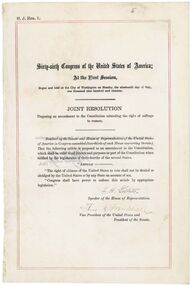
Contrary to a widely held belief, the 19th Amendment was not universally supported by women in the United States. Moreover, there was a significant amount of support for extending suffrage to women within the male population. Another misconception is that women were denied the vote at the time of the formation of the United States, which in fact women could vote in many elections on the local and state level in the colonies and in the early days of the Republic. Likewise, many states had already extended the voting franchise to women for local, state, and even national elections before the passage and ratification of the amendment.
In fact, only seven states -- Pennsylvania, Maryland, West Virginia, Virginia, North Carolina, South Carolina and Alabama -- did not have any form of women's suffrage at the time the Amendment became law. Western States had been among the first to extend full suffrage to women, whereas New York and Michigan were the only states east of the Mississippi River to have done so.
Mississippi was the last state to ratify the Amendment (among those existing at the time of its proposal) on March 22, 1984
 RSS Feed
RSS Feed